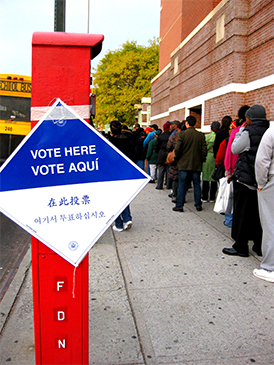Activity 2: Defining Terms: Democracy versus Authoritarian Rule
 |
| 2008 Voting Line in Brooklyn (Attribution) |
Democracy is a form of government in which supreme power lies with the people who exercise that power by voting in elections.
Essential elements of democracy include: Majority rule; all adults have equal rights under law including the right to vote in free, fair, and regular elections; the peaceful transfer of power to newly elected leaders following elections; freedom of speech; freedom of the press (news media); and freedom of peaceful assembly (the right to join groups to protest or to promote any lawful cause).
Related term: Republic. The term republic is often used interchangeably with the term democracy. In the United States, the two main political parties are called the Republicans and the Democrats (written with a capital R and a capital D). The term republic implies representative democracy, rather than direct democracy.
Direct democracy: The people exercise power directly as they did in ancient Athens where all citizens could vote on new laws. In the United States, citizens may participate in direct democracy when they vote in elections to approve or disapprove proposed state laws or state constitutional amendments.
Representative democracy: The people exercise power indirectly by electing representatives to make laws on behalf of the people. The United States is a representative democracy in which voters elect senators and representatives to represent the wishes of the voters at the national and state levels. The people also elect leaders for their local communities, including mayors, city council members, and county commissioners.
Authoritarian rule is essentially the opposite of democracy. Under an authoritarian system, one person or a small group rules the country without approval from the people through elections. Freedoms such as freedom of religion, freedom of the press, freedom of speech, freedom of assembly, and the right to vote in free and fair elections are typically limited or eliminated under authoritarian rule.
 |
| Totalitarian Leaders: Joseph Stalin (left) and Adolph Hitler (right). (Attribution) |
Related term: Totalitarian rule. This term implies an extreme form of authoritarian government that exercises nearly total control over people’s lives. Examples from history include the Soviet Union under Joseph Stalin and Nazi Germany under Adolph Hitler.
Types of authoritarian rule:
- Autocracy: Power is concentrated in one person.
- Monarchy: Supreme power lies with a hereditary monarch such as a king, queen, or emperor.
- Dictatorship: One person takes control of government, often with help from the military.
- Oligarchy: Rule by a small group of powerful people.
- Theocracy: Rule by a religious leader or leaders.
Check Your Understanding
- Can a theocracy be an oligarchy?
- Can a monarchy be an autocracy?
- Can an autocracy be an oligarchy?
- What is the biggest difference between authoritarian rule and democratic rule?
- The government of the United States may best be described as a (choose one: direct democracy / representative democracy / It has elements of both).
- What is the main difference between authoritarian government and totalitarian government?
- Which system of government is likely to provide the greatest personal freedoms to its people? (autocracy / representative democracy / oligarchy / totalitarian rule / authoritarian rule)
- In your opinion, which system appears to be the better form of government (it provides the greatest good for the greatest number of people): democracy or authoritarian rule? Why?